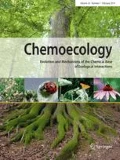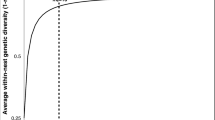Abstract
In queenright colonies of stingless bees of the genus Melipona, workers recognize, attack, and kill young virgin queens. For Melipona scutellaris, we observed that virgin queens were executed when they were between 5 and 9 days old, while newly emerged queens were not attacked. The faster movements of old virgin in relation to newly emerged might be responsible for attacks. It has been also hypothesized that cuticular hydrocarbons are the source of the signal used by workers to recognize virgin queens. We investigated whether newly emerged, 8 days old virgin and physogastric queens of M. scutellaris have different cuticular hydrocarbon profiles. Cuticular hydrocarbons of three ages were compared using gas chromatography-mass spectrometry. The cuticular hydrocarbon profiles varied by reproductive status and age. Changes in the cuticular hydrocarbons in virgin queens during aging suggest that these compounds, together with change in movement, may play a role in the recognition of virgin queens by workers prior to regicide.

Similar content being viewed by others
References
Abdalla FC, Cruz-Landim C (2002) Glândulas exócrinas das abelhas. Funpec, Ribeirão Preto
Abdalla FC, Jones GR, Morgan ED, Cruz-Landim C (2003) Comparative study of the cuticular hydrocarbon composition of Melipona bicolor Lepeletier, 1836 (Hymenoptera, Meliponini) workers and queens. Genet Mol Res 2:191–199
Abdalla FC, Jones GR, Morgan ED, Cruz-Landim C (2004) Chemical composition of the Dufour gland secretion in queens of Melipona bicolor (Hymenoptera, Meliponini). J Braz Chem Soc 15:621–625
Amsalem E, Orlova M, Grozinger CM (2015) A conserved class of queen pheromones? Re-evaluating the evidence in bumblebees (Bombus impatiens). Proc R Soc B 282:20151800
Anderson MJ (2005) PERMANOVA: a FORTRAN computer program for permutational multivariate analysis of variance. Department of Statistics, University of Auckland, New Zealand
Biseau JC, Passera L, Daloze D, Aron S (2004) Ovarian activity correlates with extreme changes in cuticular hydrocarbon profile in the highly polygynous ant, Linepithema humile. J Insect Physiol 50:585–593
Bonavita-Cougourdan A, Theraulaz G, Bagnères AG, Roux M, Pratte M, Provost E, Clement JL (1991) Cuticular hydrocarbons, social organization and ovarian development in a polistine wasp: Polistes dominulus Christ. Comp Biochem Physiol 100:667–680
Caliman MJF (2008) Caracterização do perfil de hidrocarbonetos cuticulares de operárias, rainhas virgens e rainhas fisogástricas de Melipona marginata Lepeletier, 1836 (Hymenoptera, Apinae, Meliponini). Dissertação de Mestrado, Universidade de São Paulo
Carlson DA, Offor II, El Messoussi S, Matsuyama K, Mori K, Jallon JM (1998) Sex pheromone of Glossina tachinoides: isolation, identification and synthesis. J Chem Ecol 24:1563–1574
Carlson DA, Geden CJ, Bernier UR (1999) Identification of pupal exuviae of Nasonia vitripennis and Muscidifurax raptorellus parasitoids using cuticular hydrocarbons. Biol Control 15:97–106
Chaline N, Sandoz JC, Martin SJ, Ratnieks FL, Jones GR (2005) Learning and discrimination of individual cuticular hydrocarbons by honeybees (Apis mellifera). Chem Sen 30:327–335
Cuvillier-Hot V, Cobb M, Malosse C, Peeters C (2001) Sex, age and ovarian activity affect cuticular hydrocarbons in Diacamma ceylonense, a queenless ant. J Insect Physiol 47:485–493
Dani FR, Jones GR, Corsi S, Beard R, Pradella D, Turillazzi S (2005) Nestmate recognition cues in the honey bee: differential importance of cuticular alkanes and alkenes. Chem Sens 30:477–489
Dietemann V, Peeters C, Liebig J, Thivet V, Hölldobler B (2013) Cuticular hydrocarbons mediate discrimination of reproductive and nonreproductive in the ant Myrmecia gulosa. Proc Natl Acad Sci USA 100:10341–10346
Elias-Neto M, Nascimento ALO, Bonetti AM, Nascimento FS, Mateus S, Garófalo CA, Bitondi MMG (2013) Heterochrony of cuticular differentiation in eusocial corbiculate bees. Apidologie 45:397–408
Engels W, Imperatriz-Fonseca V (1990) Caste development, reproductive strategies, and control of fertility in honey bees and stingless bees. In: Engels W (ed) Social insects: an evolutionary approach to castes and reproduction. Springer, Berlin, pp 167–230
Everaerts C, Farine J, Cobb M, Ferveur J (2010) Drosophila cuticular hydrocarbons revisited: Mating status alters cuticular profiles. PLoS One 5:e9607
Falcon T, Ferreira-Caliman MJ, Nunes FMF, Tanak ED, Nascimento FS, Bitondi MMG (2014) Exoskeleton formation in Apis mellifera: Cuticular hydrocarbons profiles and expression of desaturase and elongase genes during pupal and adult development. Insect Biochem Mol 50:68–81
Ferreira-Caliman MJ, Nascimento FS, Turatti IC, Mateus S, Lopes NP, Zucchi R (2010) The cuticular hydrocarbons profiles in the stingless bee Melipona marginata reflect task-related differences. J Insect Physiol 56:800–804
Guerino AC, Cruz-Landim C (2003) Ocorrência e morfologia das glândulas tegumentares do abdome de algumas abelhas (Hymenoptera: Apidae): Um estudo comparado. Neotrop Entomol 32:261–267
Hora RR, Ionescu-Hirsh A, Simon T, Delabie J, Robert J, Fresneau D, Hefetz A (2008) Postmating changes in cuticular chemistry and visual appearance in Ectatomma tuberculatum queens (Formicidae: Ectatomminae). Naturwissenschaften 95:55–60
Howard RW, Blomquist GJ (2005) Ecological, behavioural, and biochemical aspects of insect hydrocarbons. Annu Rev Entomol 50:371–393
Imperatriz-Fonseca VL, Zucchi R (1995) Virgin queens in stingless bee (Apidae, Meliponinae) colonies: a review. Apidologie 26:231–244
Izzo A, Wells M, Huang Z, Tibbetts E (2010) Cuticular hydrocarbons correlate with fertility, not dominance, in a paper wasp, Polistes dominulus. Behav Ecol Sociobiol 64:857–864
Jarau S, Van Veen J, Aguilar I, Ayasse M (2009) Virgin queen execution in the stingless bee Melipona beecheii: the sign stimulus for worder attacks. Apidologie 40:496–507
Kather R, Martin SJ (2015) Evolution of cuticular hydrocarbons in the Hymenoptera: A meta-analysis. J Chem Ecol 41:871–883
Kerr WE, Zucchi R, Nakadaira JT, Butolo JE (1962) Reproduction in the social bees (Hymenoptera: Apidae). J New York Entomol Soc 70:267–276
Kerr WE, Jungnickel H, Morgan ED (2004) Workers of the stingless bee Melipona scutellaris are more similar to males than to queens in their cuticular compounds. Apidologie 35:611–618
Kleinert AMP (2005) Colony strength and queen replacement in Melipona marginata (Apidae: Meliponini). Braz J Biol 65:469–476
Kleinert AMP, Imperatriz-Fonseca VL (1994) Virgin queen refuges in colonies of Melipona marginata (Apidae, Meliponinae). Braz J Biol 54:247–251
Koedam D (1999) Production of queens, workers and males in the stingless bee Melipona favosa (Apidae: Meliponinae): pattern in time and space. Neth J Zool 49:289–302
Koedam D, Aguilar MI, Sommeijer MJ (1995) Social interactions of gynes and their longevity in queenright colonies of Melipona favosa (Apidae: Meliponinae). Neth J Zool 45:480–494
Legendre P, Legendre L (2003) Numerical ecology, 2nd edn. Elsevier, Amsterdam
Michener CD (1974) The social behavior of the bees. Harvard University Press, Cambridge
Monnin T (2006) Chemical recognition of reproductive status in social insects. Ann Zool Fen 43:515–530
Nelson DR, Dillwith JW, Blomquist GJ (1981) Cuticular hydrocarbons of the house fly, Musca domestica. Insect Biochem 11:187–197
Nunes TM, Turatti ICC, Lopes NP, Zucchi R (2009a) Chemical signals in the stingless bee, Frieseomelitta varia, indicate caste, gender, age and reproductive status. J Chem Ecol 35:1172–1180
Nunes TM, Turatti ICC, Mateus S, Nascimento FS, Lopes NP, Zucchi R (2009b) Cuticular hydrocarbon in the stingless bee Schwarziana quadripunctata (Hymenoptera, Apidae, Meliponini): differences between colonies, castes and age. Genet Mol Res 8:589–595
Nunes TM, Morgan ED, Drijfhout FP, Zucchi R (2010) Caste-specific cuticular lipids in the stingless bee Friesella schrottkyi. Apidologie 41:579–588
Nunes TM, Mateus S, Favaris AP, Amaral MFZJ, von Zuben LG, Closoki GC, Bento JMS, Oldroyd BP, Silva R, Zucchi R, Silva DB, Lopes NP (2014) Queen signals in a stingless bee: suppression of worker ovary activation and spatial distribution of active compounds. Sci Rep 4:7449
Oppelt A, Heinze J (2009) Mating is associated with immediate changes of the hydrocarbon profile of Leptothorax gredleri ant queens. J Insect Physiol 55:624–628
Peeters C, Monnin T, Malosse C (1999) Cuticular hydrocarbons correlated with reproductive status in a queenless ant. Proc R Soc Lond B 266:1323–1327
Polerstock AR, Eigenbrode SD, Klowden MJ (2002) Mating alters the cuticular hydrocarbons of female Anopheles gambiae sensu stricto and Aedes aegypti (Diptera: Culidae). J Med Entomol 39:545–552
Pomonis JG (1989) Cuticular hydrocarbons of the screwworm, Cochliomyia hominivorax (Diptera: Calliphoridae). Isolation, identification and quantification as a function of age, sex and irradiation. J Chem Ecol 15:2301–2317
Sakagami SF, Oniki Y (1963) Behaviour studies of the stingless bees, with special reference to the oviposition process. I Melipona compressipes manaosensis Schwarz J Fac Sci Hokkaido Univ Ser VI Zool 15:300–318
Sakagami SF, Montenegro MJ, Kerr WE (1965) Behaviour studies of the stingless bees, with special reference to the oviposition process. V. Melipona quadrifasciata anthidioides Lepeletier. J Fac Sci Hokkaido Univ Ser VI Zool 15:578–607
Santos DE, Souza EA, Vieira CU, Zanuncio JC, Serrão JE (2015) Morphology of mandibular and intramandibular glands in workers and virgin queens of Melipona scutellaris. Apidologie 46:23–34
Santos-Filho PS, Alves DA, Eterovic A, Imperatriz-Fonseca VL, Kleinert AMP (2006) Numerical investment in sex and caste by stingless bees (Apidae: Meliponini): a comparative analysis. Apidologie 37:207–221
Silva DLN, Zucchi R, Kerr WE (1972) Biological and behavioural aspects of the reproduction in some species of Melipona (Hymenoptera, Apidae, Meliponinae). Anim Behav 20:123–132
Sommeijer MJ, De Bruijn LLM, Meeuwsen FJAJ, Martens EP (2003) Natural patterns of caste and sex allocation in the stingless bees Melipona favosa and M. trinitalis related to worker behavior. Insect Soc 50:38–44
Sousa CS, Serrão JE, Bonetti AM, Amaral IMR, Kerr WE, Maranhão AQ, Ueira-Vieira C (2013) Insights into the Melipona scutellaris (Hymenoptera, Apidae, Meliponini) fat body transcriptome. Gen Mol Biol 36:292–297
Van Den Dool H, Kratz PD (1963) A generalization of the retention index system including linear temperature programmed gas-liquid partition chromatography. J Chromatogr A 11:463–471
Van Oystaeyen A, Oliveira RC, Homan L, van Zweden JS, Romero C, Oi CA, d’Ettorre P, Khalesi M, Billen J, Wäckers F, Millar JG, Wenseleers T (2014) Conserved class of queen pheromones stops social insect workers from reproducing. Science 343:287–290
Van Veen JW, Sommeijer MJ, Aguilar MI (1999) Behavioural development and abdomen inflation of gynes and newly mated queens of Melipona beecheii (Apidae, Meliponinae). Insect Soc 46:361–365
Wenseleers T, Hart AG, Ratnieks FLW, Quezada-Euàn JJG (2004) Queen execution and caste conflict in the stingless bee Melipona beecheii. Ethology 110:725–736
Will S, Delabie JHC, Heinze J, Ruther J, Oetller J (2012) Cuticular lipid profiles of fertile and non-fertile Cardiocondyla ant queens. J Insect Physiol 58:1245–1249
Wossler TC, Jones GE, Allsopp MH, Hepburn R (2006) Virgin queen mandibular gland signals of Apis mellifera capensis change with age and affect honeybee worker responses. J Chem Ecol 32:1043–1056
Acknowledgements
This research was supported by grants of Fundação de Amparo à Pesquisa de Minas Gerais-PRONEX EDT #522/07 for JES, and Fundação de Amparo à Pesquisa do Estado de São Paulo #2011-17708-0 and Conselho Nacional de Pesquisa #306103-2013-3 for JRT.
Author information
Authors and Affiliations
Corresponding author
Additional information
Handling Editor: Günther Raspotnig.
Rights and permissions
About this article
Cite this article
de Souza, E.A., Trigo, J.R., Santos, D.E. et al. The relationship between queen execution and cuticular hydrocarbons in stingless bee Melipona scutellaris (Hymenoptera: Meliponini). Chemoecology 27, 25–32 (2017). https://doi.org/10.1007/s00049-016-0226-9
Received:
Accepted:
Published:
Issue Date:
DOI: https://doi.org/10.1007/s00049-016-0226-9




